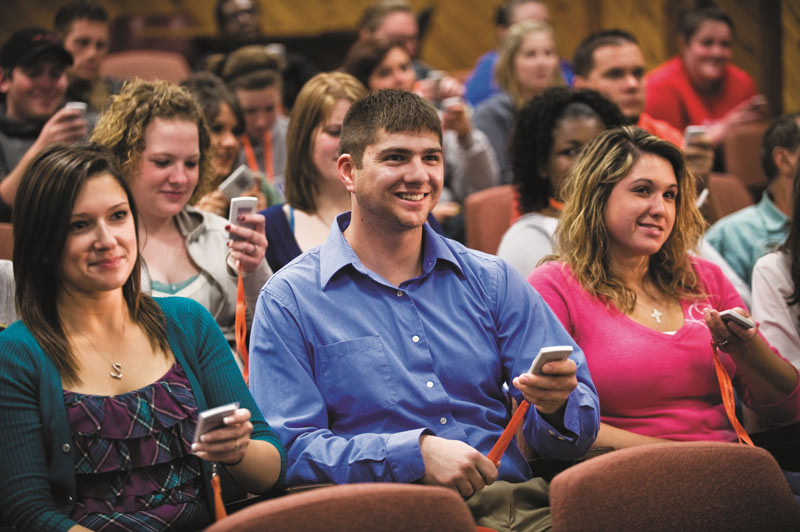Rethinking Physics Education
Fall
2015
Special Feature
Rethinking Physics Education
Exploring cutting-edge physics education research
By:Carl Wieman, Professor of Physics, Stanford University in Palo Alto, CA, and 2001 Physics Nobel Laureate

The science of how physics is best taught and learned at the undergraduate level has led to considerable innovation in the teaching of physics. Physics education research (PER) is a relatively new and growing field of physics research, carried out by physicists, and recognized in the physics community with its own Physical Review Special Topics journal sponsored by the American Physical Society and the American Association of Physics Teachers.
Physics has led the way among the sciences in this type of research, but other disciplines, such as biology and earth sciences, are now copying many of the ideas and research approaches to good effect.
One of the early results of PER was better measures of learning. Carefully designed tests probed how well students could use concepts like a physicist. Those tests showed that many college students could complete typical textbook and exam problems very successfully, but when confronted with simple real-world situations were unable to apply basic concepts as a physicist would to correctly understand or predict behavior.
Early work also revealed particular areas of physics that students found difficult. That work led to experiments in teaching that explicitly targeted areas of student difficulty and had students more directly practice explanations and the use of basic concepts. In carefully controlled experiments, students taught in this way showed dramatically improved conceptual mastery compared to similar groups of students who were taught by the traditional lecture format.
Touching on all of these areas and more has been the introduction of technology into the teaching of physics, as well as research on its effectiveness and how to optimize that effectiveness. This includes research on various types of personal response systems in the classroom, computer-based homework, interactive simulations, and other computer tools.
PER research findings and research-based teaching innovations are slowly but steadily changing how physics is being taught, particularly at the introductory undergraduate level. It is now much more common to find students in a physics class working out problems, discussing and answering questions in small groups, and providing reasoning and conceptual arguments, rather than simply listening to the instructor lecture. The instructor’s role has also evolved in response to this research. They are acting more to guide students, responding to specific student difficulties and questions rather than simply attempting to rapidly transfer information.
A recent direction in PER is to more directly couple the work to findings in cognitive psychology. Insights from that field into how the brain functions and organizes and processes ideas are being increasingly applied in PER. This includes the cognitive psychology research on what makes up thinking like an “expert” (in this case a practicing physicist) and how that expertise develops only as a result of intense practice on the specific components of thinking, with guided feedback that provides a general framework for understanding many of the past observations and successes of PER and suggests areas of future research.
Another new area of PER that is providing immediate dividends for innovations in teaching is learning in upper-division physics courses. Although there is relatively little work, so far it shows that most of the same methods of measuring and improving learning demonstrated in introductory courses provide similar benefits when appropriately mapped onto the content and thinking involved for advanced material.
A very new area of PER research is stand-alone laboratory courses. For a long time, lab courses have been problematic parts of the physics curriculum. One approach that PER has studied for some time, and demonstrated the benefits of, is to eliminate stand-alone lab courses and instead have small experiments and/or interactive lecture demonstrations integrated into a course. PER researchers have now begun to examine stand-alone lab courses at all levels to understand how and why they are failing to achieve many of the intended learning goals and how they might be modified to become more effective.
Another relatively small but growing area of PER research activity is to move beyond looking at the composite learning of all the students in a course and explore more deeply the variations across groups of individuals. This couples with research on the social-psychological factors of learning math, science, and engineering. We can anticipate this research leading to future innovations that are similar in principle to what has been demonstrated for students in general, but also can provide a deeper understanding of the learning challenges and more effective teaching methods for different subpopulations of students taking physics courses.
Despite the progress made, an ongoing challenge is to convince many physics faculty to use a scientific PER approach to teaching, rather than relying on tradition. If you have an interest in education, I encourage you to read the literature and explore the exciting, emerging science of physics education research. //
Educate Yourself
For more information on how different sciences are improving learning, see “Discipline Based Education Research,” a synthesis study by the National Research Council that was funded by the National Science Foundation at
www.nap.edu/catalog/13362/discipline-based-education-research-understanding-and-improving-learning-in-undergraduate.
To dive deeper into PER advances, see “Lessons from the Physics Education Reform Effort” by Richard Hake at Indiana University at
www.ecologyandsociety.org/vol5/iss2/art28/.
Check out Wieman's 2011 Science article, “Improved Learning in a Large-Enrollment Physics Class,” on why active learning trumps lecturing at
www.sciencemag.org/content/332/6031/862.abstract.
Or read his 2005 Physics Today article, “Transforming Physics Education,” at
https://physicstoday.scitation.org/doi/10.1063/1.2155756

